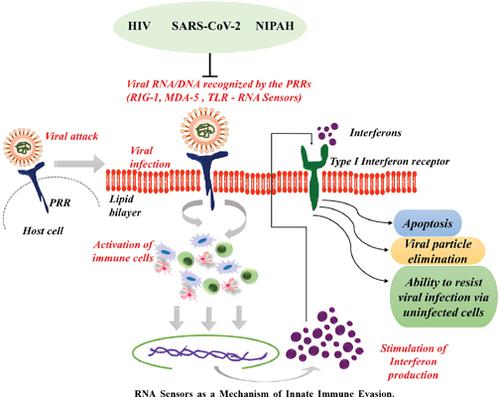Current Protein & Peptide Science ( IF 2.8 ) Pub Date : 2021-03-31 , DOI: 10.2174/1389203722666210322142725 Dalia Cicily Kattiparambil Dixon 1 , Chameli Ratan 1 , Bhagyalakshmi Nair 1 , Sabitha Mangalath 1 , Rachy Abraham 2 , Lekshmi R Nath 1

|
Innate immunity is the first line of defence elicited by the host immune system to fight against invading pathogens such as viruses and bacteria. From this elementary immune response, the more complex antigen-specific adaptive responses are recruited to provide a long-lasting memory against the pathogens. Innate immunity gets activated when the host cell utilizes a diverse set of receptors known as pattern recognition receptors (PRR) to recognize the viruses that have penetrated the host and responds with cellular processes like complement system, phagocytosis, cytokine release and inflammation and destruction of NK cells. Viral RNA or DNA or viral intermediate products are recognized by receptors like toll-like receptors(TLRs), nucleotide oligomerization domain (NOD)-like receptors (NLRs) and retinoic acid-inducible gene I (RIG-I)-like receptors (RLRs) thereby, inducing type I interferon response (IFN) and other proinflammatory cytokines in infected cells or other immune cells. But certain viruses can evade the host innate immune response to replicate efficiently, triggering the spread of the viral infection. The present review describes the similarity in the mechanism chosen by viruses from different families -HIV, SARSCoV- 2 and Nipah viruses to evade the innate immune response and how efficiently they establish the infection in the host. The review also addresses the stages of developments of various vaccines against these viral diseases and the challenges encountered by the researchers during vaccine development.
中文翻译:

RNA 传感器作为 SARSCoV2、HIV 和 Nipah 病毒先天免疫逃避的机制
先天免疫是宿主免疫系统对抗入侵病原体(如病毒和细菌)的第一道防线。从这种基本的免疫反应中,可以招募更复杂的抗原特异性适应性反应,以提供针对病原体的持久记忆。当宿主细胞利用称为模式识别受体 (PRR) 的多种受体来识别已经穿透宿主并以补体系统、吞噬作用、细胞因子释放和炎症以及 NK 破坏等细胞过程作出反应的病毒时,先天免疫被激活细胞。病毒 RNA 或 DNA 或病毒中间产物被受体识别,如 Toll 样受体 (TLR),核苷酸寡聚化结构域 (NOD) 样受体 (NLR) 和视黄酸诱导基因 I (RIG-I) 样受体 (RLR),从而在受感染细胞或其他免疫系统中诱导 I 型干扰素反应 (IFN) 和其他促炎细胞因子细胞。但某些病毒可以逃避宿主先天免疫反应以有效复制,从而引发病毒感染的传播。本综述描述了来自不同家族的病毒——HIV、SARSCoV-2 和尼帕病毒——逃避先天免疫反应的机制的相似性,以及它们如何有效地在宿主中建立感染。该评论还讨论了针对这些病毒性疾病的各种疫苗的开发阶段以及研究人员在疫苗开发过程中遇到的挑战。在感染细胞或其他免疫细胞中诱导 I 型干扰素反应 (IFN) 和其他促炎细胞因子。但某些病毒可以逃避宿主先天免疫反应以有效复制,从而引发病毒感染的传播。本综述描述了来自不同家族的病毒——HIV、SARSCoV-2 和尼帕病毒——逃避先天免疫反应的机制的相似性,以及它们如何有效地在宿主中建立感染。该评论还讨论了针对这些病毒性疾病的各种疫苗的开发阶段以及研究人员在疫苗开发过程中遇到的挑战。在感染细胞或其他免疫细胞中诱导 I 型干扰素反应 (IFN) 和其他促炎细胞因子。但某些病毒可以逃避宿主先天免疫反应以有效复制,从而引发病毒感染的传播。本综述描述了来自不同家族的病毒——HIV、SARSCoV-2 和尼帕病毒——逃避先天免疫反应的机制的相似性,以及它们如何有效地在宿主中建立感染。该评论还讨论了针对这些病毒性疾病的各种疫苗的开发阶段以及研究人员在疫苗开发过程中遇到的挑战。引发病毒感染的传播。本综述描述了来自不同家族的病毒——HIV、SARSCoV-2 和尼帕病毒——逃避先天免疫反应的机制的相似性,以及它们如何有效地在宿主中建立感染。该评论还讨论了针对这些病毒性疾病的各种疫苗的开发阶段以及研究人员在疫苗开发过程中遇到的挑战。引发病毒感染的传播。本综述描述了来自不同家族的病毒——HIV、SARSCoV-2 和尼帕病毒——逃避先天免疫反应的机制的相似性,以及它们如何有效地在宿主中建立感染。该评论还讨论了针对这些病毒性疾病的各种疫苗的开发阶段以及研究人员在疫苗开发过程中遇到的挑战。



























 京公网安备 11010802027423号
京公网安备 11010802027423号